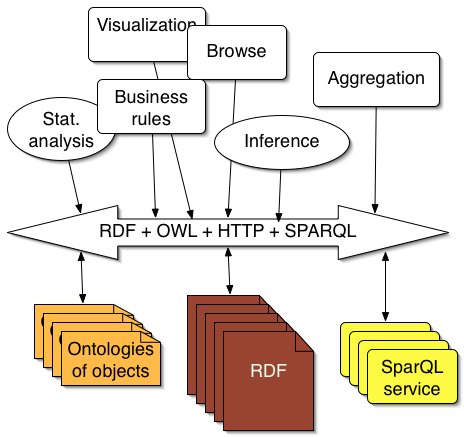RDF: Difference between revisions
Jump to navigation
Jump to search
m (using an external editor) |
m (using an external editor) |
||
| Line 33: | Line 33: | ||
<?xml version="1.0"?> | <?xml version="1.0"?> | ||
<rdf:RDF xmlns:rdf="http://www.w3.org/1999/02/22-rdf-syntax-ns#" | <rdf:RDF xmlns:rdf="http://www.w3.org/1999/02/22-rdf-syntax-ns#" | ||
xmlns:mon_schema="http://tecfa.unige.ch/lib/mon_schema" > | |||
<rdf:Description rdf:about="http://tecfa.unige.ch/perso/staf/lattion/"> | <rdf:Description rdf:about="http://tecfa.unige.ch/perso/staf/lattion/"> | ||
<mon_schema:Creator>Stéphane Lattion</mon_schema:Creator> | <mon_schema:Creator>Stéphane Lattion</mon_schema:Creator> | ||
| Line 68: | Line 68: | ||
* [http://www.oasis-open.org/cover/rdf.html Oasis Resource Description Framework (RDF)] | * [http://www.oasis-open.org/cover/rdf.html Oasis Resource Description Framework (RDF)] | ||
* [http://www.w3.org/TR/NOTE-rdfarch W3C Data Formats] A older (1997) note on the planned XML-centered framework | * [http://www.w3.org/TR/NOTE-rdfarch W3C Data Formats] A older (1997) note on the planned XML-centered framework | ||
* Chris Waterson, [http://developer.mozilla.org/en/docs/RDF_in_Fifty_Words_or_Less RDF in Fifty Words or Less], Mozilla Magazine. | |||
* [http://www.w3.org/PICS/ PICS] (Platform for Internet Content Selection) | * [http://www.w3.org/PICS/ PICS] (Platform for Internet Content Selection) | ||
Revision as of 11:19, 13 November 2006
Definition
- The Resource Description Framework (RDF) is a language for representing information about resources in the World Wide Web.
- Originally RDF was primarily intented to represent metadata about Web resources, such as the title, author, and modification date of a Web page, copyright and licensing information about a Web document, or the availability schedule for some shared resource. However, by generalizing the concept of a "Web resource", RDF can also be used to represent information about things that can be identified on the Web, i.e. the semantic web.
Major RDF vocabularies
- Metadata
- Content syndication and social software
- RSS 1.0 which is not very popular, most RSS formats are not RDF since bloggers don't understand issues related to the semantic web :)
- FOAF Friends-of-a-friend vocabulary for person networks
- Semantic Web
- OWL
- SparQL (Query language)
RDF basics
At its core, RDF has a simple relational data model: Subject - Verb - Object or expressed differently Predicate (Subject, Object)
- Sujet = The resource
- Objet = Value
- Verb = Predicate = propriety = relation of the subjet with the object
Here is a typical RDF fragment
<?xml version="1.0"?> <rdf:RDF xmlns:rdf="http://www.w3.org/1999/02/22-rdf-syntax-ns#" xmlns:mon_schema="http://tecfa.unige.ch/lib/mon_schema" > <rdf:Description rdf:about="http://tecfa.unige.ch/perso/staf/lattion/"> <mon_schema:Creator>Stéphane Lattion</mon_schema:Creator> </rdf:Description> </rdf:RDF>
It expresses a relation like this:
RDF and the semantic web
The RDF Software stack
The RDF bus
Links
Standards
- RDF Primer
- Resource Description Framework (RDF) Overview
- The Resource Description Framework (RDF) Model and Syntax.
- SPARQL Query Language for RDF (last checkedwas: W3C Working Draft 17 February 2005)
Overviews
- Mozilla's RDF pointers
- Oasis Resource Description Framework (RDF)
- W3C Data Formats A older (1997) note on the planned XML-centered framework
- Chris Waterson, RDF in Fifty Words or Less, Mozilla Magazine.
- PICS (Platform for Internet Content Selection)
On-line validation
Various to sort out
- Supercharging WSDL with RDF Managing structured Web service metadata article by Uche Obbuji
- Rudolf: RDFViz Exploring tools for RDF Graph Visualisation by Dan Brickely, project page.
References
- Eric Miller An Introductionto the Resource Description Framework (1998), D-Lib Magazine May 1998, ISSN 1082-9873, HTML


